Helix for Neanderthals – Butch Walker’s Beastly Bag of Tricks
by James Rotondi
In the lexicon we musicians use to praise our own, Butch Walker gets the ultimate accolade: the man is a total beast. Where do we start? Well, he’s got a size 13 foot, okay? He’s the producer, engineer, and co-songsmith behind albums by Green Day, Pink, The Struts, Weezer, Gavin DeGraw, Train, and Avril Lavigne. He’s a widely admired cult figure in his own right by virtue of his former band The Marvelous 3, high priests of the heavier end of power-pop, as well as for his own high-octane, Springsteen-like marathon live shows, and his prolific string of sonically monstrous solo albums, including last year’s politically pointed American Love Story.
Liberally tattooed, mentally tough, and blessed with a full-spectrum skill set, Walker is a kind of Jimmy Page for the digital age: a rock and roller through and through, but with the leading-edge studio savvy, performance chops, and guitar smarts to back up the badass. We caught up with Walker at his Franklin, Tennessee recording studio as he was finishing updating his Helix Rack and HX Stomp units to Version 3.0. Grabbing a vintage Telecaster and firing up his console, Butch walked us through his favorite Helix amp, cab/mic, and effects blocks, his preferred preset architecture, and his sophisticated live and in-studio Helix signal-routing paths. He also shared several handy tricks for giving your Helix workflow the kind of natural, spontaneous ease that will allow you to “paint” those guitar colors readily.
“There’s always a good use for Helix,” says Walker. “There it is. Ready to rock. Right now.”
Helix can certainly be a great study for players who are really into tweaking otherworldly sounds for serious effects “performances.” That doesn’t quite sound like you, though.
Oh, man. As anyone who has seen my show will tell you, I’m an absolute Neanderthal on stage. I’m not one of those guitarists who stares at his pedalboard and does everything delicately. I need to have this stuff bullet-proof, where I can run by it and jump on a pedal and keep moving without worrying, “Oh, did I turn that up too far?” I can’t worry about any of that, because I’m entertaining a crowd. Half the time I’ve got a microphone in one hand and I’m playing guitar with the other. I’m not thinking much about my pedalboard, so I need to be able to trust that I can hit something and it’s going to do the right thing.
This is why, for example, I have my SP1-L6H Mission Expression Pedal often set so that I can take my Helix delay mix settings from totally dry to only around 40%, so if I want, I can get that wild, swelling echo thing as needed, sure, but it doesn’t go too far. I literally have to make it all caveman-proof for my big-ass feet, too, which is also a problem. I have a size 13 foot! I can literally come down with one foot and hit seven buttons. So, no “nano” pedals for me!
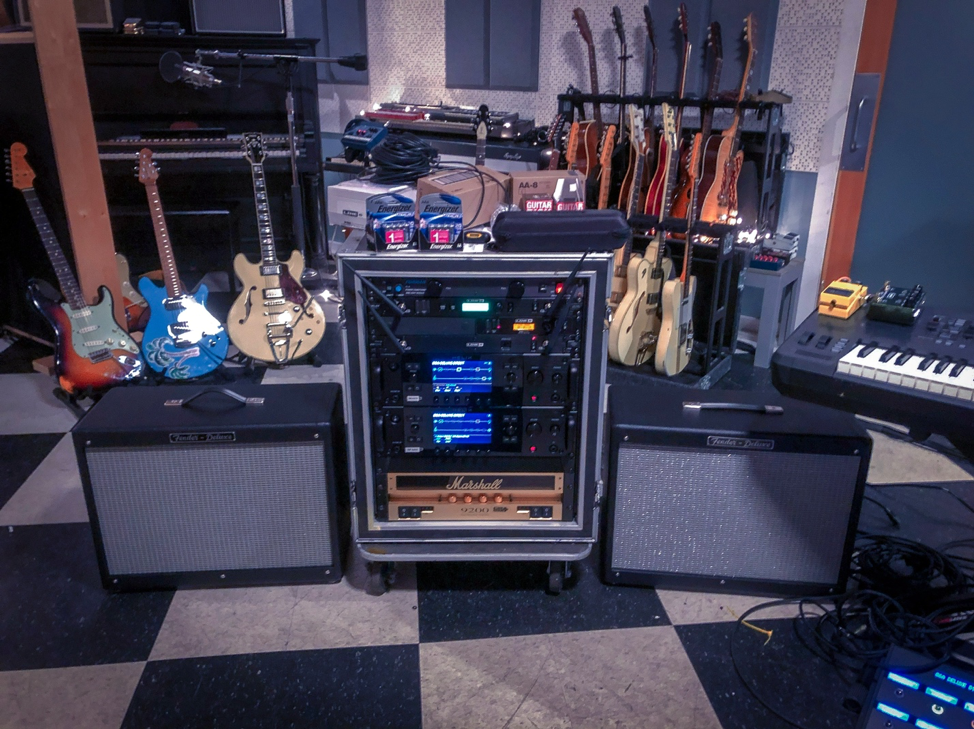
Rack Attack: Walker’s touring rig includes two Helix Rack processors, a Line 6 Relay G90 wireless system, a Line 6 XD-AD-8 Antenna Distribution unit, a Furman Power Conditioner, and the coveted Marshall 9200 Gold Dual Monobloc Stereo Power Amplifier with EL84s, for giving those Helix patches full lift-off in the live arena. The Marshall drives two Fender Deluxe 112 80-watt extension cabinets loaded with Celestion G12P-80 speakers.
So, talk to me then about your live Helix rig, which I understand you used on your last tour before the pandemic stopped us all in our tracks.
My live Helix rig was pretty epic on my last tour of the States a couple of years ago. In a sense it was a logical, way downsized and simplified update of the big Bradshaw switching system and the big refrigerator-sized rack I used to haul around in the Nineties. Now, live I use the super badassLine 6 G90 Relay rackmount wireless system, into my Helix Rack from which I run a long, very thick pro-grade Ethernet cable out to my Helix Control Foot Controller, out to upstage center where my mic stand lives. This is great because there’s no audio cable loss with long signal cable runs—all it’s sending is MIDI protocol.
We run the XLR stereo outs on the Helix straight to the house and to monitor world—we didn’t even mic my cabinets, which I was using, by the way, but more on that in a second. So it was the same great, dependable sound every night. At the outset, part of me just wanted to find out if I would enjoy not having a single amp on stage, and not a single additional foot pedal—just the foot controller and expression pedal and Helix, going straight to FOH in stereo through my favorite cab/speaker IRs, like Greenback 25s or Vintage 30-style speakers. And you know what? It was awesome. Super consistent and sounded great.
So, back to the actual cabinets on stage. As great as the Helix sound was out front, I still wanted a little more pushed air from my guitar on stage. What I did was I configured the Helix for multi-outs, and I ran another stereo pair of ¼” cables out to a Marshall 9200 Stereo Tube Power Amp—minus the cab IRs—to two Fender Deluxe 112 extension cabinets, one on either side of the stage. Now, I’m fine with sending my IRs directly to the front of house, but I’m still a guy who wants to feel some amplifier thump behind me on stage, and I didn’t get that feeling from just pumping the IRs to FOH and through the wedges and sidefills.
That’s also the reason I don’t even use in-ear monitors; I tried them for a couple tours and they don’t work for me. I use the best wedges I can get. So I just cranked those 1×12 cabinets. And because they’re only 1×12, they didn’t blow everyone away on the stage or in the front row, but they got some proper air moving, and that was awesome for me. With the stereo thing, especially with ping-pong delays, maybe a little chorus, I was totally channeling my inner Steve Lukather! And if the power amp ever went down—as it did on occasion—I’d still be good because I still had this great Helix sound going to the mains. Needless to say, the Helix never, ever broke down.
You also use the Helix Rack units in both your California and Tennessee studios, is that right?
Yep, I use a Helix Rack in both studios, and the 12-button Helix Control Foot Controller sits right under the console when I work. The Helix Rack sits right behind me in the rack with my other rack gear, opposite the computer, console, and keyboard, and I can just find a Helix preset and arm the track. Done. That way I can easily call up my four or five favorite Helix amp presets for direct recorded guitar. While I do sometimes record mono parts as needed, I generally go for the stereo outputs, which I love because I like to take advantage of the stereo effects in Helix.
To make things even simpler, out at my California studio, I would use the little Line 6 Relay G10 transmitter, the one that plugs directly into your guitar. I didn’t even need to plug anything in! I just had a little 1-in, 5-out splitter box, and I had the G10 going into the input of that, and each output goes to either the Helix rack, or the HX Stomp into a live amp, or any one of a bunch of different amps. Now, even if we decide the wireless track is not the end-all-and-be-all take, it’s still just so immediate and easy to press record and track guitar. In fact, we did end up using a lot of those tracks on this Billy Idol album I’ve been producing, with the great Steve Stevens on guitar. A lot of those were done with the Relay G10; we didn’t replace them with a take using a real cable because, honestly, they sounded just as good. I think it’s pretty unlikely anyone would have said, “Gee, Butch, it kind of sounds like you’re using a wireless . . .” [laughs].
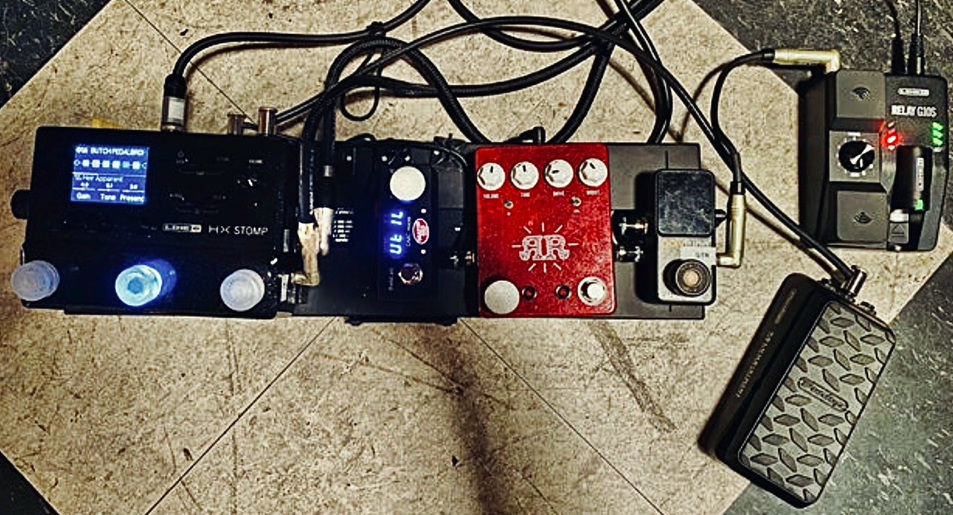
Little Beast, Big Teeth: Walker’s compact fly-rig features a Line 6 Relay G10S wireless system, a t.c. electronic PolyTune Noir, Walker’s own signature JHS Ruby Red Overdrive/Boost pedal, and an HX Stomp connected to a Disaster Area Designs DMC.micro MIDI controller and a Dunlop DVP Mini Volume/Expression pedal. Note the Barefoot Buttons V2 Tallboy Footswitch Caps on all the switches.
That studio splitter concept makes sense. On your last album, American Love Story, you have an incredible range of tones, especially ones evoking a certain era in great studio guitar playing.
Thanks. I recorded that last year during the first months of the pandemic. It’s a big ode to all the great commercial radio rock hits of the late ’70s and early ’80s that I grew up with, so there’s a lot of that real slick production, giant hi-fi drums, and those big guitar sounds and solos. And a good half of that record was my Helix Rack—a lot of my lead sounds, the clean, chorusey rhythm sounds, you name it. The thing about Helix is, you can just plug it in and pull up your sound so quickly and there it is. I didn’t have to mess with a bunch of mics and mic placement; I knew I had sounds that worked, and boom, there it was.
I should tell you, I mess with everybody who asks me about whether I used a certain “real” amp or the Helix on American Love Story, on that lead or that certain rhythm guitar part. I say, “Well, what does it sound like to you?” And then they don’t want to say because they don’t want to get it wrong! The truth is, guitar tone is totally subjective. In the end, it doesn’t matter how you get to the finish line. There are no rules on how you get your sound, as long as what you get is good.
So, tell me about some of your go-to Helix amp and cab models and favorite effects for creating convincing classic amp and effect combinations.
Sure. One of my go-to amps is the US Deluxe amp on the bright second channel setting. Another favorite in there that I love is the Divided Duo; I use that amp a ton. Sounds great with a little Red Squeeze compression on it, to get that real spongy sound. Or I’ll add the Teemah! in front of it, back off the gain a little bit, and use that as a little extra gain and boost. I love that sound, just real woody and organic, and I can still really hear the sound of the guitar. Roll off the volume pot on your guitar a little, and it cleans up for a really nice and slightly different character. That sounds great with a touch of PlastiChorus for sort of that late-’70s Pretenders sound. The PlastiChorus also has that great Michael Landau vibe, since it’s based on the Arion SCH-Z chorus pedal. I love that Divided Duo amp, as well as the real Divided By 13 JRT 9/15 amp that it’s modeled after. With a sound like that. I’ll have a Ping Pong delay set up, as well, with the mix at around 20% for that “sound-checking in an arena” thing.
Your gain-y sounds always have a nice old-school thump to them; they sure aren’t wimpy.
Thanks, man. A lot of that is just going in and messing with the parameters, y’know? In this Divided Duo case, for instance, I’m using a stock amp/cab hybrid block in Helix, but for starters, I went in and changed the speaker cabinet from a 1×12 to a 2×12 Match G25 with Greenback 25s, and I changed the microphone to a 160 Ribbon, which is like a Beyer-Dynamic M160. I’ll usually decide between that or a 121 Ribbon, basically a Royer R-121. Any of the ribbon mic models you see when you scroll through the Helix mic menu are going to be inherently a little darker, with more warmth, and less “bitey” on top.
Generally, I’ll also add a bit of the vintage Echoplex-style Transistor Tape slap to a sound like this, where it adds some subtle distortion characteristics to the sound. And I’ll make that pretty heavy, like around a 150ms, 30-40% wet, very rockabilly-style slap, and I do prefer that before the amp, not in the effects loop, because something cool happens to the sound of your amp when it’s getting pushed by the extra gain in an Echoplex. This is what Jimmy Page did; placed an Echoplex set to a slap just before his Marshalls and turned the input gain way up on the Echoplex so it acts as a kind of overdrive pedal with a slap delay. It makes all the difference in your sound. I have to say, the effects in Helix are just unbelievable. I could have a full rack of Eventides and Lexicons and all that stuff that I used to have back in the day, or I can just have . . . Helix. And the even cooler thing is that, since I started using Helix, there’s never been a time when it hasn’t been part of my guitar rig in some way, regardless of whether I’m using no external amps, or all external amps with 4-cable method or effects loop, or just power-amp and cabinet. Really, in any setup I can imagine. There’s always a good use for Helix.
More about Helix: https://line6.com/helix/

Guitarist and writer James Rotondi has been a Senior Editor at Guitar Player and Guitar World, a contributor to Rolling Stone, JazzTimes, Acoustic Guitar, Mojo, and Spin, and has toured with the acclaimed bands Mr. Bungle, Humble Pie, and French electro-rock group Air. He lives in Nashville.
Related posts
By submitting your details you are giving Yamaha Guitar Group informed consent to send you a video series on the Line 6 HX Stomp. We will only send you relevant information. We will never sell your information to any third parties. You can, of course, unsubscribe at any time. View our full privacy policy

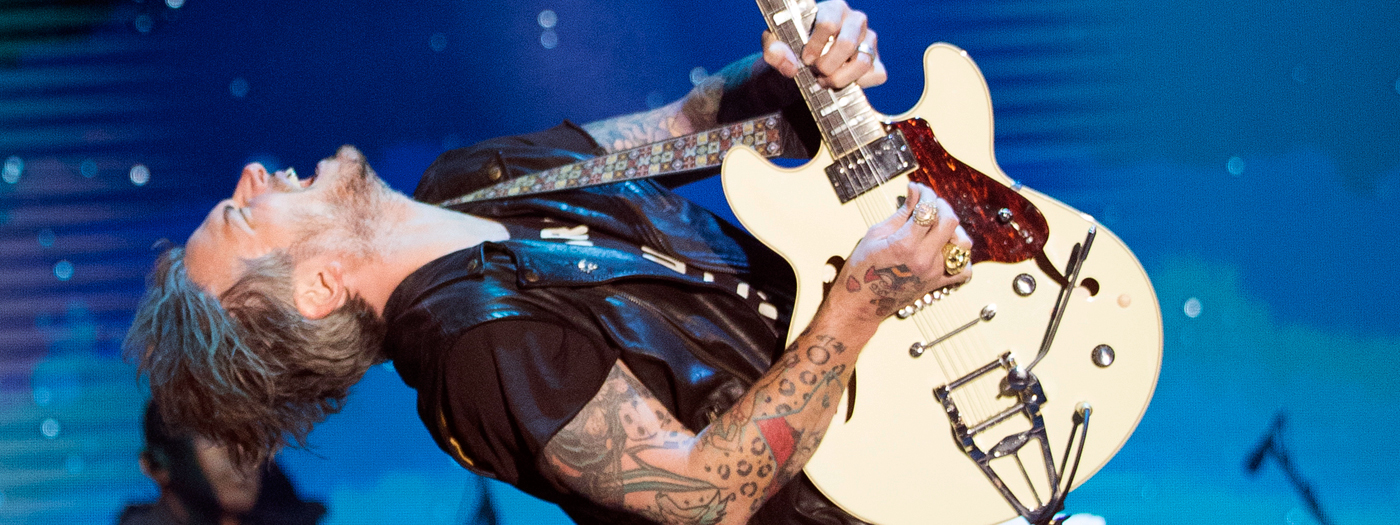
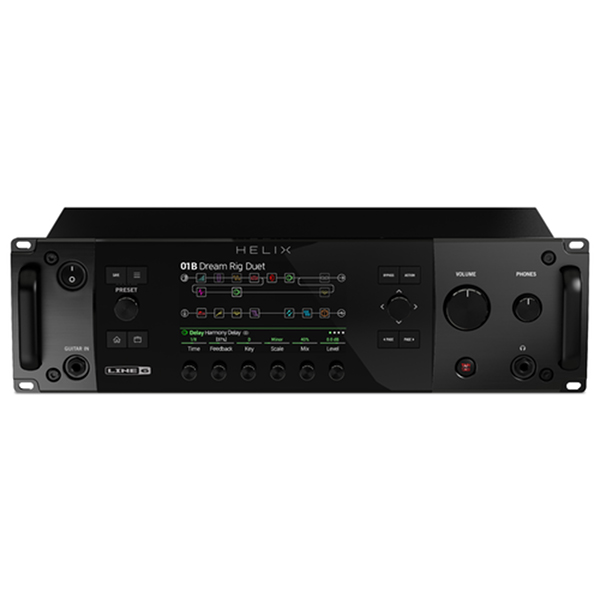
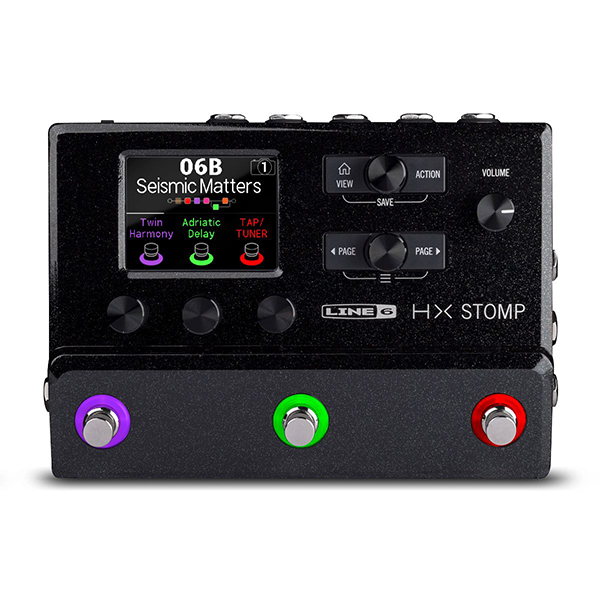
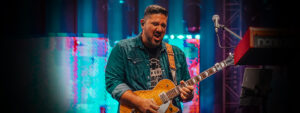
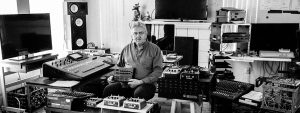

Leave a Reply
You must be logged in to post a comment.